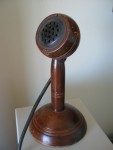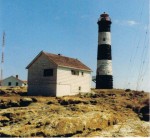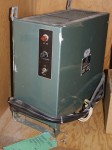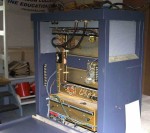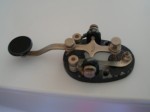 This keypad was used for the telegraphic communications in Morse Code over the radio in the early years.See link to communications |
|||
Some time in the 1980’s the Coastguard installed a Radio network which connected the lightstations. It wasn’t until the late1980s that VHF radios became the method of communication at Race Rocks. In 2000, with the millennium project, Lester Pearson College installed the V(oice) O(ver) I(nternet) P(rotocol) installed at Race Rocks. This provided, through a microwave link to the Lester Pearson College phone exchange, the first regular telephone service to Race Rocks. See the technology index.
| In March 2010, I had a conversation with Trevor Anderson about the radio communications when he was at Race Rocks from 1966 to 1982.. Below are some of his thoughts about communications at that time. |
| The radio beacon at Race Rocks came under a different government department. They had installed a small generator for the beacon alone. The same applied for the radio equipment. The Sequential radio beacon: Before the days of GPS, ships at sea along the Strait of Juan de Fuca had available in some areas a position fixing system which relied on a radio signal broadcast from a series of shore stations. There were 6 stations broadcasting from radio beacons in the Juan de Fuca /Georgia Strait area. Five were located at American sites and Race Rocks was the only one broadcasting from Canada on that frequency . Some of the other stations on the circuit with the radio beacons were at Port Angeles, Neah Bay, and Shelter Island. There was a non-directional wire antennae from the engine room where the radio was housed. The 6 stations were all on the same frequency. Each station sent out a Morse code letter ( From Race Rocks it was the letter J in Morse code) every 6 minutes, so each station had 1 minute per station when the code was broadcast in sequence. This relied of course on accurate timing, and Trev said that they had a wind-up clock which would occasionally go out. Then it wasn’t long until the Americans were phoning to alert him. |
| For Canadian Coastguard communications there was an AM radio network for the Lightstations all up and down the Coast. Weather reports were broadcast from Prince Rupert to Race Rocks on the 1850 frequency. I asked Trev if that network could be used for lightkeepers to talk to other stations, he said ” Only after midnight and then the Coastguard didn’t approve of that.”One of the problems with operating radio broadcasting equipment was that the radios operated by large tubes which would frequently need to be replaced, so Trev said his radio repair kit was always handy. He came with good radio skills however as he had been trained in communications when he was in the Second World War. He was the communications officer aboard a Lancaster Bomber which was shot down over the Mediterranean Sea when flying missions with the British Air force in North Africa. To this day he and his group from the Canadian Air Force who were assigned to work with the British in North Africa, have gone pretty well unrecognized for their heroic missions. He also has an incredible story of his miraculous escape through the window of his radio room of the bomber.Garry Fletcher, March, 2010 |


